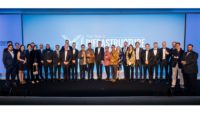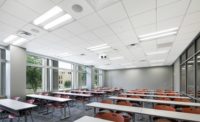One North, a commercial development in Portland, Ore., features the kind of design that makes digital documentation a must. What changed: advancements in technology. Computer-based design and digital fabrication have made more complex structures, with more complex framing, possible and affordable, within today’s demanding schedules. Digital systems allow architects and engineers to define unique shapes, and give fabricators the computer-control to accurately produce custom structural members. The digital information created at the beginning of the process is carried through every step, and elaborated by each member of the construction team, from the architect’s imagination right through fabrication.
A contractor who can utilize those digital documents will have a greater likelihood of success constructing the building correctly. Even better, that tech-savvy contractor can become one of the people with input, involved in the project at an early stage to help identify constructible solutions, and resolve conflicts before they happen. By embracing technology, framing contractors can work more closely with design professionals, specialty fabricators and GCs to earn better projects that can be built seamlessly and more cost effectively.
Digital Collaboration
Virtual 3-D coordinated design has become the norm for architecture and engineering. A 3-D model describes a building more accurately. A building information model not only shows the design in a way that is clearer and more revealing than 2-D drawings, but also gives direct access to the specifications that support it, the product information and submittals, etc. It’s all in one place, coordinated and integrated. Some models use 4-D (scheduling), and 5-D (cost). The model can continue to grow, reflecting as-built information, and becoming a permanent asset of the building used for commissioning, operational instructions, maintenance record-keeping, repair and renovation. Digital documentation is valuable at every stage, and businesses that can make use of it and contribute to it can leverage that value to win significant projects.
One North, East & West Buildings Project Team:Design Architect: Holst Architects |
The nature of the collaboration depends greatly on which stage the project has reached when the contractor becomes involved. Contractors and specialists are brought into a project during design if they can add value for the architect, engineer, or owner. Traditionally, design professionals have delegated the details of light gauge framing, leaving it to the framing contractor/installer. With increasingly complex architecture, earlier focus on light gauge framing identifies and eliminates clashes, locates structural framing components, and provides more accurate budget estimates - which all save time and money.
During the design phase, the architect consults with engineers and other specialties such as mechanical trades or framing consultants. For example, Radius Track Corp. makes prefabricated custom framing systems for complex projects, and also acts as a subject matter expert (SME) during the design phase. Radius Track offers Design Assist services that can be as targeted as doing a feasibility study for a particular area of focus, or as extensive as a fully engineered framing solution for an entire project.
A framing contractor can provide valuable insight into that process, making him a natural partner for the SME. In the process, the contractor can get an inside track on the project.
The biggest framing installers have already embraced 3-D modeling and BIM. They advertise that capability, and they are getting to the table early in significant projects. Any contractor can follow that path by a) becoming tech savvy and b) making their technical expertise known to GCs with whom they’ve worked and custom fabricators. Even an installing contractor that cannot afford the full software investment can still learn to use digital documents, and can leverage the software capabilities of others on the team (architect, engineer, custom fabricator), to offer valuable input. 3-D models can be output as 3-D PDFs that can be read by virtually anyone with a computer and some instruction.
Adding Value
A recent project serves as a good example of how consultation with a specialist can add value to the design process (by saving a huge amount of money) and win a great job. Karuna East & West Buildings at One North, a commercial development in Portland, Ore., are high design, high quality, high efficiency buildings targeted at LEED Platinum certification. They are built with heavy timber framing and feature curved walls clad in natural cedar. The most prominent features are three- and four-story “stacks” of large, irregularly-shaped, projecting apertures around the windows.
The GC, R&H Construction, who had a negotiated contract and was involved during the design phase, had worked previously with RTC and suggested bringing them in to consult, even though the project was already far along in developing construction documents for the East Building. R&H also had a previous relationship with Fred Shearer & Sons, the oldest light-gauge framing contractor in Portland (founded 1916), and brought them in. Fred Shearer & Sons is a digitally ramped-up shop that offers full wall and ceiling modeling and coordination.
RTC offered two possible levels of design assist, but the project was so far into development that it was felt there wasn’t sufficient remaining budget to utilize the service. RTC, believing strongly that a light gauge solution would save weight, and thus a lot of time and money – in effect creating additional budget – went ahead and developed a concept on spec.
The apertures had been designed as structural steel frames, cages that would be attached to steel columns built into the timber framing. RTC jettisoned the concept of individual cages for each aperture (with redundant “floor” and “ceiling” framing) and approached each group of apertures as a “stack” composed of vertical trusses and horizontal decks. Each truss and deck, and each light-gauge member of these elements, was individually engineered, but they shared common framing rules and logic.
This proposal saved enough money that RTC was engaged to design and fabricate all the aperture stacks on the East Building, and provide a fully engineered solution for the West Building.
The framing contractor knew the digital language and had the programs available for framing QA/QC. Additionally, they were able to get into the models and act as a collaborator with the GC and RTC. They helped review and interpret the aperture framing drawings and shop drawings, using a combination of the 3-D model and 2-D hard copy.
By being digitally capable, the framing contractor/installer was able to provide valuable assistance and insight into the constructability of the system being developed. Project teams seeking framing expertise at any phase should contact a subject matter expert to help deliver unique designs cost effectively with a more clearly defined schedule.












Report Abusive Comment